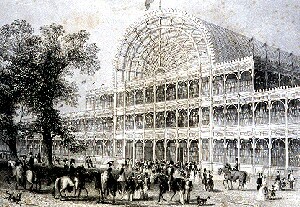|
1 |
 Copyright: Tallis 1852, Bd. 1, S. 4 |
|
1 |
 Copyright: Tallis 1852, Bd. 1, S. 4 |
Queen Victoria’s diary entry on the day of the opening of the exhibition:
“This day is one of the greatest and most glorious in our lives and, to my joy and pride, will forever be associated with the name of my beloved Albert! It is a day that has filled my heart with gratitude. […] The view through the iron gates onto the cross nave, the billowing palm trees, flowers, statues, the myriad of people occupying all the galleries and chairs, with all the fanfares as we entered: all of this gave us a feeling that I will never forget. I was very moved. […] As we stepped into the centre where the stairs and throne (on which I did not sit) had been erected – directly before us the wonderful crystal well – such a magical sight awaited us – so overwhelming, glorious, touching. One felt – like so many others with whom I have spoken since – inspired with devotion, more than in any mass I have ever heard. The mighty cheers, the happiness that shone from every face, the building’s enormous size, the mixture of palm trees, flowers, trees, statues, wells, the organ (with 200 stops and 600 voices – it sounded like nothing before) and my beloved husband, the originator of this “peaceful festival”, which unites the diligence of all the nations of the earth – all of this was indeed moving, and it has been and it is a day that ought to last forever. God bless my Albert, God bless my beloved country that has distinguished herself so nobly today. One feels so grateful to the great God who seemed to imbue and bless everything and everyone!”
Lothar Bucher, cultural historical sketches from the Great Exhibition of the Works of Industry of all Nations (1851):
“Paxton’s Crystal Palace: The building’s beauty, which has so often been discussed and argued over, in which we move around, is in my opinion based on the impossibility of achieving the singular aim with the given materials of iron and glass any better than Paxton has done. […] We see a fine network of symmetrical lines, but without a clue as to make a judgement about their distance from the eye, or the real size of its meshes. The sidewalls are too distant to be caught in one glance, and instead of finding an opposite wall, the eye moves upward along an infinite perspective, the end of which blurs into a blue haze. We do not know whether the building is suspended 100 or 1,000 feet above us, whether the roof is flat or made up of a number of small parallel roofs; because the casting of shadows, which usually helps the soul to understand the visual nerve’s impression, is entirely lacking. As we let our gaze wander down again, it meets the perforated carrier beams painted blue, initially in wide gaps, then moving ever closer, then overlapping, then pierced by a gleaming beam of light, finally dissolving into a distant background, in which everything corporeal, even the line, disappears and only colour remains. Only the side walls give us some orientation as, out of the mass of tapestries, tissues, animal furs, mirrors and a thousand other draperies, we select a single free pillar – so slim that it seems it were not there in order to support, but only in order to satisfy the eye’s needs for a support. The light beam, which breaks the perspective line of support beams, is the cross nave. It is due to the sober economy of language that I call the sight of it incomparable, fairylike. It is a piece of summer night dream in the mid-day sun.”
| Year: 1851 | City: London | Country: Great Britain |
| Duration: 1st May - 11th October 1851 | ||